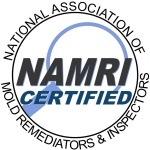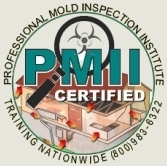Preventing Mold In Your Home
Keep your loved ones safe from the harmful effects of mold exposure.

Mold and mildew (mold in its early stage) are fungi that
grow quickly anywhere there is moisture. They serve an
important purpose in our environment by helping to destroy
organic materials such as leaves, thereby enriching the
soil. But that same attribute can cause a serious health
issue for people living in a moldy home: respiratory
problems; sinus congestion; eye, nose, or throat irritation;
and headaches. Infants, children, pregnant women, elderly
individuals, and people with existing respiratory conditions
are at a higher risk for these problems.
Check for areas in your home where there could be high
humidity or water damage, such as a damp basement or crawl
space. Mildew and mold can grow on wood products, ceiling
tiles, cardboard, wallpaper, carpets, drywall, fabric,
plants, foods, and insulation. These growths can begin to
develop on a damp surface within 24 and 48 hours and produce
spores that travel through the air. They will break down and
destroy whatever they're growing on and can cause mild to
severe health problems for you and your family.
Tips For Preventing Mold In Your Home
GTA Mold Removal recommends the following precautions to avoid potential mold problems from developing inside your home:
Identify problem areas in your home and correct
them. You can't mold-proof your home, but you can make
it mold-resistant. Do an audit of your home: where are the
problem areas? Does the basement flood? Do you notice
frequent condensation on an upstairs window? Is there a
water stain on the ceiling from a persistent leak?
Preventing mold from growing or spreading might be as simple
as ripping up carpet in a damp basement, installing
mold-resistant products, or repairing damaged gutters. Or it
may be a matter of major excavation and waterproofing.
Whatever the case, address the problem now. It might cost
some money up front, but it will surely be more costly down
the road if mold continues to grow unchecked.
Dry wet areas immediately. Mold can't grow without
moisture, so tackle wet areas right away. Seepage into the
basement after a heavy rainfall, accumulation from a leaky
pipe, even a spill on the carpet should be dried within 24
to 48 hours. If you've experienced a flood, remove
water-damaged carpets, bedding, and furniture if they can't
be completely dried. Even everyday occurrences need
attention: don't leave wet items lying around the house, and
make sure to dry the floor and walls after a shower. Don't
leave wet clothes in the washing machine, where mold can
spread quickly. Hang them to dry - preferably outside or in
areas with good air circulation.
Prevent moisture with proper ventilation. It may
be that your routine domestic activities are encouraging the
growth of mold in your home. Make sure an activity as simple
as cooking dinner, taking a shower, or doing a load of
laundry doesn't invite mold by providing proper ventilation
in your bathroom, kitchen, laundry room, and any other
high-moisture area. Vent appliances that produce moisture -
clothes dryers, stoves - to the outside (not the attic). Use
AC units and dehumidifiers (especially in humid climates),
but make sure they don't produce moisture themselves by
checking them periodically and cleaning them as directed by
the manufacturer. Your energy-efficient home may be holding
moisture inside, so open a window when cooking or washing
dishes or showering, or run an exhaust fan.
Equip your home with mold-resistant products.
Building a new home or renovating an old one? Use
mold-resistant products like mold-resistant drywall or
mold-resistant Sheetrock, and mold inhibitors for paints.
Traditional drywall is composed of a gypsum plaster core
pressed between plies of paper. Mold-resistant drywall is
paperless - the gypsum core is covered in fiberglass, making
the surface highly water-resistant. Moisture-resistant
drywall is especially valuable in areas prone to wetness,
such as bathrooms, laundry rooms, basements, and kitchens.
Not only is traditional drywall more susceptible to mold
than the paperless kind, but it is also difficult to rid of
mold, and removal and replacement can be expensive.
Mold-resistant gypsum board is also available; the core of
the drywall is developed in such a way to prevent moisture
absorption, and thus prevent mold growth.
Monitor humidity indoors. The EPA recommends
keeping indoor humidity between 30 and 60 percent. You can
measure humidity with a moisture meter purchased from your
local hardware store. You'll also be able to detect high
humidity by simply paying attention to potential problem
areas in your home. Telltale signs of excessive humidity
include condensation on windows, pipes, and walls. If you
notice condensation, dry the surface immediately and address
the source of moisture (for example, turn off a humidifier
if water appears on the inside of nearby windows).
Direct water away from your home. If the ground
around your home isn't sufficiently sloped away from the
foundation, water may collect there and seep into your
crawlspace or basement.
Clean or repair roof gutters. A mold problem might
be a simple matter of a roof that is leaking because of full
or damaged gutters. Have your roof gutters cleaned regularly
and inspected for damage. Repair them as necessary, and keep
an eye out for water stains after storms that may indicate a
leak.
Improve air flow in your home. According to the
EPA, as temperatures drop, the air is able to hold less
moisture. Without good air flow in your home, that excess
moisture may appear on your walls, windows and floors. To
increase circulation, open doors between rooms, move
furniture away from walls, and open doors to closets that
may be colder than the rooms they're in. Let fresh air in to
reduce moisture and keep mold at bay.
Keep mold off household plants. They're beautiful
and help keep your indoor air clean - and mold loves them.
The moist soil in indoor plants is a perfect breeding ground
for mold, which may then spread to other areas of your
house. Instead of getting rid of your plants, try adding a
bit of Taheebo tea to the water you give to your
houseplants. The oil of this tree, which withstands fungi
even in rain forests, helps hinder mold growth in plant soil
and can be found at natural food stores.







